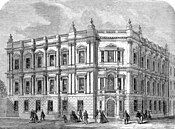Westminster St James
| Westminster St James | |
|---|---|
 | |
| Area | |
| • 1881 | 815 acres (3.30 km2) |
| • 1901 | 766 acres (3.10 km2) |
| • 1921 | 767 acres (3.10 km2) |
| Population | |
| • 1881 | 29,941 |
| • 1901 | 21,588 |
| • 1921 | 13,644 |
| History | |
| • Origin | Bailiwick of St James |
| • Created | 1685 |
| • Abolished | 1900 (vestry) 1922 (civil parish) |
| • Succeeded by | Metropolitan Borough of Westminster |
| Status | Civil parish |
| Government | St James Vestry (1685–1900) |
| • HQ | Vestry Hall, Piccadilly |
Westminster St James (or St James Piccadilly) was a
Creation
There were attempts in 1664, 1668 and 1670 to create a new parish, with its own church, from the area of the bailiwick of St James within the ancient parish of St Martin in the Fields. The creation of the new parish was resisted by the vestry of St Martin in the Fields. In 1684 the Church of St James, Piccadilly, was constructed which improved the case for providing a new parish.[1]
| St. James' Parish, Westminster Act 1685 | |
|---|---|
| Act of Parliament | |
 1 Ja. 2. c. 10 | |
| Dates | |
| Royal assent | 27 June 1685 |
It was created in 1685 from part of the ancient parish of St Martin in the Fields, and was within the
The legislation creating the parish in 1685 provided for a
Geography
It corresponded to the western portion of the contemporary district of
Government
The parish adopted the
Under the
The Local Government Act 1894 reformed the method of election for London vestries, with the entire vestry replaced at an election held on 15 December 1894. One third of the vestry was then elected every year starting in 1896.
Poor law
The parish was independent for the administration of the
Abolition
In 1889 the parish became part of the
Population
The population of the parish as recorded in the decennial census was:[6]
| Year | 1801 | 1811 | 1821 | 1831 | 1841 | 1851 | 1861 | 1871 | 1881 | 1891 | 1901 | 1911 | 1921 |
|---|---|---|---|---|---|---|---|---|---|---|---|---|---|
| Population | 34,462 | 34,093 | 33,819 | 37,053 | 37,398 | 36,406 | ? | 33,619 | 29,941 | 24,995 | 21,588 | 16,159 | 13,644 |
References
- ^ "The Parish and Vestry of St. James - British History Online".
- ISBN 0-901050-67-9.
- ^ Reginald H. Adams (1971). The Parish Clerks of London. Phillimore.
- ^ The London Gazette Issue: 21802. 20 October 1855. pp. 3884–3887. Retrieved 8 April 2015.
- ^ "H.M.S.O. Boundary Commission Report 1885 Westminster Map". Vision of Britain. Retrieved 8 April 2015.
- ^ "Westminster St James/Vest through time - Population Statistics - Total Population".


